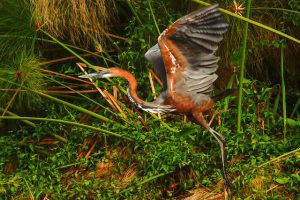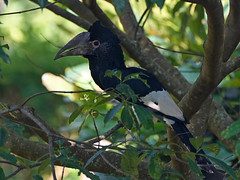What is the best time for birding in Uganda
 Uganda boasts an ever burgeoning bird list of over 1000 bird species, making it the richest African birding destination. On the list, are many special birds like the Shoebill and numerous spectacular endemics of the Albertine Rift Valley that are difficult or impossible to find elsewhere. With its diverse landscapes, rich biodiversity and numerous protected areas, Uganda provides a unique and unparalleled birding experience. Whether you choose the dry season for clear visibility and migrant arrivals or the wet season for lush landscapes and breeding activities, Uganda guarantees a memorable birding experience.
Uganda boasts an ever burgeoning bird list of over 1000 bird species, making it the richest African birding destination. On the list, are many special birds like the Shoebill and numerous spectacular endemics of the Albertine Rift Valley that are difficult or impossible to find elsewhere. With its diverse landscapes, rich biodiversity and numerous protected areas, Uganda provides a unique and unparalleled birding experience. Whether you choose the dry season for clear visibility and migrant arrivals or the wet season for lush landscapes and breeding activities, Uganda guarantees a memorable birding experience.
What is the best time for birding in Uganda?
The best time for birding in Uganda is definitely the dry season. Uganda experiences two primary seasons; the dry and wet, where each (season) offers a distinct birding experience. The dry season typically runs from December to February and June to September, while the wet season occurs from March to May and October to November. The best time of the day is the early morning and evening. Also note that birding in Uganda is possible all year round especially if interested in resident birds. The decision to do a birding trip at a particular time of the year should therefore be based on your personal preferences and target species.
The Dry Season – December to February and June to September
Less or no rain during the dry season doesn’t interfere with the birding time/sessions and food for the birds is abundant. This makes it easy to spot a variety of birds. If targeting the Albertine Rift Endemics in Mgahinga and Bwindi, their main nesting season is May and June. There is less rain in December and January but from mid-April to mid-May, the rains might still be too heavy in this part of the country.
During the dry season, the birding trails in the parks and the roads leading to the birding destinations are drier and generally accessible. It is easier to access even the remote birding hotspots like Toro-Semuliki Wildlife Reserve which is the only place in East Africa to see many Guinea-Congo regional species. The reserve is wet for the most part of the year and only dry between February and early March.
The dry season is also favorable for observing breeding behaviors as many species are engaged in courtship displays and nesting activities. If your interest is in the migrants, the dry season coincides with the migration of several bird species, both intra-African migrants and Palearctic migrants.
The clear skies and reduced foliage during the dry season enhance visibility and make it easier to spot and identify birds. Also the abundance of sunshine allows for longer and more comfortable birding sessions.
The Wet Season – March to May and October to November
Although the rains present challenges in navigating the birding trails, there are advantages associated with bird watching during the wet months. The wet season is the peak of the breeding season for many resident bird species. The lush vegetation that comes with it also provides excellent cover for nesting. Additionally, this time witnesses the arrival of migratory birds, adding to the overall diversity.
During the wet season, the landscapes transform into a vibrant green paradise. While the dense foliage might make bird spotting a bit challenging, the stunning scenery and blooming flora create a picturesque backdrop for birding.
Compared to the dry season, the wet season attracts fewer tourists. This means less crowded birding locations, allowing for a more intimate and undisturbed birdwatching experience.
Key Birding Hotspots in Uganda
-
Bwindi Impenetrable National Park
Famous for its Mountain Gorillas, Bwindi is also a haven for birdwatchers. The park is home to over 350 bird species, including numerous Albertine Rift endemics. The African Green Broadbill and Shelley’s Crimsonwing are some of the 23 Albertine Rift endemics recorded here.
-
Queen Elizabeth National Park
This diverse park boasts a variety of habitats, from savannas to wetlands, making it a prime location for birding. Over 600 bird species have been recorded here, including the iconic shoebill stork. Some of the iconic species that attract birdwatchers include the African Fish Eagle, Martial Eagle, Grey-crowned Crane, African Skimmer, Shoebill Stork, and the White-tailed Lark. Read more about birding in Queen Elizabeth National Park.
-
Murchison Falls National Park
Positioned along the Nile River, Murchison Falls is renowned for its powerful waterfall and abundant wildlife. A variety of unique habitats and lots of superb birds make a visit to Murchison Falls Park a must for every birder. Birdwatchers can spot a variety of water birds, raptors and terrestrial species. Also of great importance to birders is the Royal Mile in Budongo forest. It is a popular birding hotspot that is part of Murchison Falls National Park. Also an exciting recent record in the park was that of a Fox’s weaver, Uganda’s only endemic bird.
- Semuliki Wildlife Reserve
- Lake Mburo National Park
- Mabamba Wetland near Entebbe
 Other Places are the national Parks of Rwenzori Mountains, Mount Elgon, Mgahinga Gorilla Park, Kibale Forest, Lake Mburo and Toro-Semuliki Wildlife Reserve.
Other Places are the national Parks of Rwenzori Mountains, Mount Elgon, Mgahinga Gorilla Park, Kibale Forest, Lake Mburo and Toro-Semuliki Wildlife Reserve.
All in all, Uganda stands as a birdwatcher’s paradise, offering a kaleidoscope of avian wonders throughout the year. Whether you are a seasoned birder or a novice enthusiast, choosing the right time to visit can significantly enhance your birding adventure. The decision to do a birding trip at a particular time of the year should therefore be based on your personal preferences and target species. With its rich biodiversity and diverse ecosystems, Uganda continues to attract bird enthusiasts from around the world. They are always eager to explore the incredible variety of feathered wonders that call Uganda home.
Recommended Birding Trips in Uganda
- 5 Days Mabamba and Murchison Falls birding
- 15 Days Uganda Birding Safari
- 25 Days Bird Watching Trip
- 1 Day Mabamba Shoebill Tour